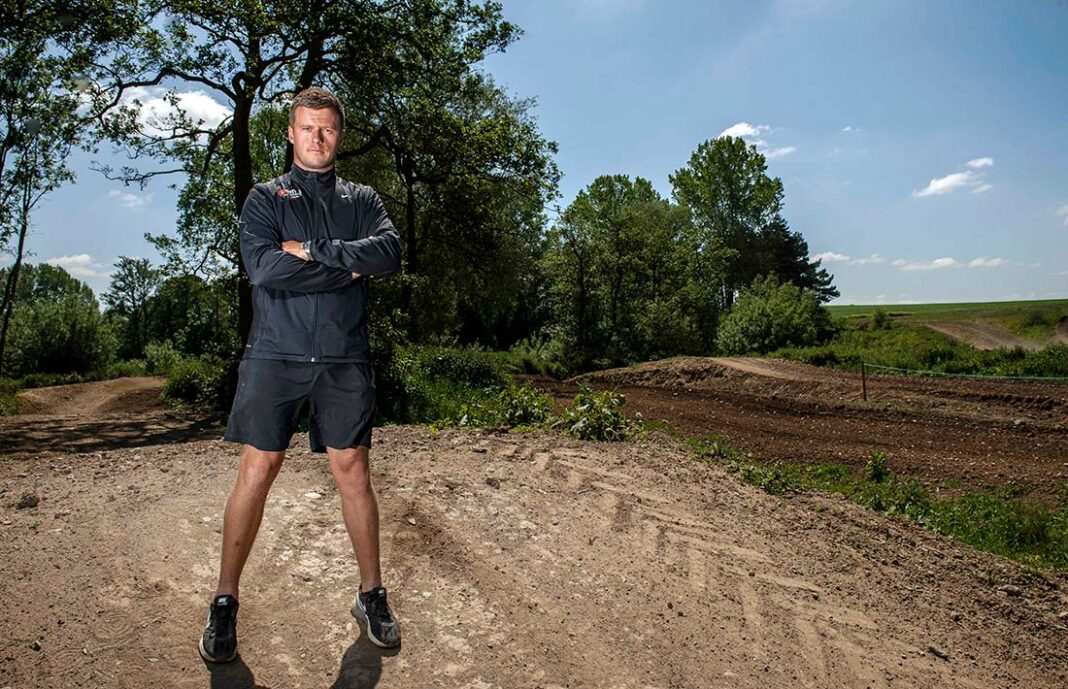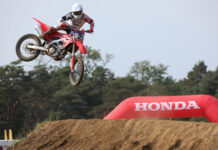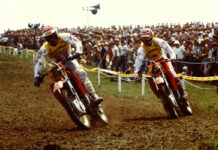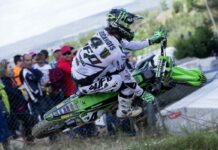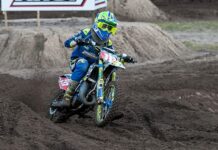When his motocross career was cut short by injury Rich-Mike Jones turned tutor, drawing on his experience to bring on the next generation of racers…
Back in the day when Trampas Parker – one of my all-time motocross heroes – was still winning 250cc GPs I had a good thing going with a feisty flame-haired primary school teacher. Being a ginge she had a light-switch temper and one comment guaranteed to send her postal was ‘those that can, do – those that can’t, teach…
Of course, that’s not strictly true and off the top of my head I can think of at least 10 former top-flight racers who are now running MX schools and passing on their years of experience to up-and-coming riders.
Richard-Mike Jones never quite made the grade as a racer. Sure, he was super-talented and very, very quick but a catalogue of injuries scuppered a promising career before he realised anywhere near his full potential. Despite this – and despite competition from trainers with much more impressive racing CVs – the 31-year-old from Caerwys in North Wales has forged a reputation as one of the country’s top MX coaches.
In fact, it’s because he didn’t make the cut as a racer that Rich-Mike feels he’s got an edge when it comes to coaching. More accurately, it’s his ability to identify his mistakes and make sure his riders don’t repeat them.
“I don’t know what makes me more successful at the moment than other coaches in terms of what they’re doing wrong but I know what I bring to it,” he says. “It’s important to be organised – to be a good leader – but why I think I’ve been able to build it up is because I realise that I did it wrong when I was racing.
“Back then I was in a bubble and just couldn’t see what was going wrong. I thought I was the most unfortunate person ever – ‘why me again?’ – but it wasn’t that, I was just getting it wrong. Completely wrong. I wasn’t prepared, I was over-trying, I lacked composure.
“All the things I was doing wrong I’d done right at different stages of my career but not realised I’d done them right. I’ve been nice and relaxed and composed and come third in a British championship race and it felt really easy. It was no stress, not a panic.”
We’ve already touched upon his injuries and at the last count Rich-Mike has broken 23 bones which is bad enough for a long career but he knocked racing on the head at 24. That’s an awful lot of experience of dealing with adversity condensed into just a few years and it’s experience he can pass on.
“Every time I came back from injury in my head I had to be challenging for third straight away and if I wasn’t third I’d be panicking and getting tight and even though I was fit I’d get absolutely knackered. And I never recognised this. I never took a step back.
“There are a lot of riders who make the same mistakes as I did and hopefully I can stop people who haven’t been through that from going through it.”
Rich-Mike retired from racing in 2007 but even then he was involved in coaching and while the RMJ Academy was still a few years off he had a number of talented riders under his wing.
“After about 18 months I’d done a few different jobs. I worked on the [family] farm, worked for Scott Acerbis as a sales rep, worked for a mobile phone company selling phones business-to-business and hated it. My passion was always motocross and I knew I had to give full-time coaching a go.
“I’d taken a massive step back from motocross but I’d always been coaching alongside my racing with Adam Derbyshire and Adam Sterry and a couple of other local lads and that didn’t stop because I had a good relationship with them.”
Sterry started with Rich-Mike during school summer holidays when he was six years old. Almost 12 years on the rider he’s guided throughout his entire career is on the verge of the MX big time…
“Adam came to me on an auto. He could ride a bike but that was pretty much it. To see how he’s doing now is mental. It’s awesome. I love it. Even down to him just going to a grand prix.
“When he took the lead in the GP [of Argentina] I actually was quite calm. The day before in the qualifying race he crashed after holes hotting and came through the pack and every time he was behind someone in that corner and they went wide he’d pass them up the inside.
“So I’d seen him come out the first turn and go up the inside and then they went out of sight and I knew he was going to lead. And then he came over the jump in front. It was amazing, amazing.”
It’s clear that Rich-Mike’s relationship with Sterry goes a long way beyond a simple coach/rider deal and as well as being a firm friend he’s responsible for steering the career of the prodigiously talented teen.
“I’m his manager as well. I spoke to a few different GP teams for this year and with Wilvo I really think he’s in the best place. I’d have preferred him to be MXGP this year which he could have been but not in the team I want him to be in. So we’ve done a two-year deal with Wilvo which will see him through into MXGP next year full-time.
“From coaching him from the age of six to him leading his first GP we’ve been together and I’m confident that one day we’ll be having a conversation about him winning his first GP and maybe more.
“It’s a brilliant story but I get equal amounts of enjoyment out of, say, one of the Rookies getting his first top 10 and seeing how happy he is and how excited his family is because that was the goal. You never hear about it in the papers because it’s not big news but it’s just as good a feeling. It’s not all about winning races for some riders – it’s about taking the next step.”
The RMJ Academy officially started five years ago and is broken down into three groups. There’s an eight-rider Pro Academy, a larger Rookie Academy and then there’s a raft of general schools that riders can book a place on as and when they want.
Sterry is the stand-out star but the RMJ Pro Academy boasts some serious talent with Ash Wilde, Nathan Dixon, Luke Norris, James Cottrell, Dexter Douglas, Matt Burrows and Jack Bintcliffe all benefitting from Rich-Mike’s tuition. There’s a fair age spread with Bintcliffe the youngest at 14 and Cottrell the oldest at 25.
Coaching is structured with a carefully worked out programme but Rich-Mike ensures there’s flexibility built into it so riders’ individual needs can be addressed.
“This year in the pre-season we went away and worked on technique to get them up to scratch. Then they started to do motos and sprint training – what they get is a programme that they come to me and work with. I set up all the dates for the year in advance so we know where we’re at but what we do isn’t rigid because it’s a living thing in the sense of we’ll do two months and see who’s progressed in what ways.
“Maybe one rider will need to do some long motos to get his mental and physical endurance up, another may need to work on sprints and another might need to work on a bit of technique. They have their own individual programmes tailored to suit their needs.”
Race day is a major part of the programme so as well as coaching two or three days a week Rich-Mike is away most weekends. To ease the burden he enlists the help of Ash Wilde.
“I’ll go to all the European grands prix this year, all the Maxxis British championship rounds and then I have Ash coaching for me alongside the Rookie Academy. I used to go to all the BYNs and now Ash will attend those when I can’t so there’s always someone there looking after my riders.
“With any sport the mental side is a massive part and on a race day I’ll speak to all my riders differently to try and get the best out of them. The riders I’ve worked with for the longest I can speak to in the morning and know whether it’s going to be an easy day or a hard day and, obviously, depending on what mood they’re in will affect how I approach them. Do I have a good stern chat with them and get them focussed or do I just let them be?”
Discipline is firm although Rich-Mike sees things from a racer’s view point and is prepared to compromise.
“The adults have to do what I say. If we have a disagreement then we’ll do it my way and if they’re still not happy then we’ll try it their way. If it’s on race day and they want to take a line and I don’t agree then we’ll do it their way because on race day they’ve got to be happy and they’ve got to take the lines they’re comfortable with.
“If we’re at a practice track and they have a line they like and I disagree then they try it my way and there’s no argument with that. If they’re not happy with it they have to persist and then, if after getting used to a line I’ve suggested and they still don’t like it, we’ll look for a solution.”
Rich-Mike works closely with physios Harris and Ross and uses highly-respected sports scientist Alan Milway to oversee his riders’ fitness and nutrition.
The RMJ Rookie Academy is, obviously, a step back from the Pro programme. The spread of ages is bigger – ranging from six up to late 20s – but it’s still a serious business and Rich-Mike isn’t willing to cut corners.
“It’s highly focussed on technique because generally with the younger riders and amateur level riders – youth and adult – they need to work on technique more than the pros do but at the same time it’s still preparing them for racing.
“Alan Milway’s involved too. The rookies go to him a couple of times in pre-season – it’s a bit more of a general programme that he gives them and an idea of what is involved so it’s a stepping stone basically.”
As well as his Pro and Rookie academies, Rich-Mike also runs general training schools. They’re a big part of his business in what’s becoming an increasingly competitive field.
“A lot of my competition as a coach comes from people who either have raced or who still race and have had a lot more successful racing careers that I had. Then they come to the end of their career looking for the next chapter and so they do coaching. They’ve got a good name already, advertise coaching days and get busy.
“When I started coaching I wasn’t all that busy and had to build it up and make a name as a coach to get to where I am now. So now I’m busy because I’m RMJ Academy and known for the coaching side of it, not just because I was a good racer.”
Early retirement – how injuries ended RMJ’s career
I first met Rich-Mike in 2002 – a decade after the carrot-topped teacher had finally reached meltdown and slung all my clothes out of her bedroom window – on a jolly to Dubai to see him running away with the Emirates MX championship. A confident, cocky 18-year-old, the series was a turkey shoot for him.
By that point he had 10 years of solid racing experience under his belt and was just embarking on what promised to be a long and successful pro career.
“We lived on a farm so I had no problem finding somewhere to ride and then I got into it after doing a couple of local races. There was no family background within the sport but on the farm I had my own track and things progressed quite quickly.
“I had a go at a national within a year and quite soon after that I won my first national so without meaning to it got serious with the whole family going away every weekend.”
It was clear to anyone watching that Rich-Mike was naturally talented but he was also impetuous, reckless and hot-tempered – factors that would hold him back and, ultimately, bring his racing career to a premature end.
“I went through the schoolboy ranks winning some races. I didn’t win a national championship but I was always either up the front or on the floor. When I was about 15 I crashed at Hawkstone Park and broke my leg in three places which was a really bad injury and it put me out for the year.
“The next year I didn’t race because of finances but came back when I was 17 for my final year in schoolboys and I think I finished second or third in the BYMX behind Bryan MacKenzie – I broke my collarbone in the second to last round while leading the championship.”
The following year he moved into the adult ranks and in the off-season raced in the Middle East after a trip to the UAE to see a mate who coached football in Dubai landed him a surprise deal.
“I had a lot of success in Dubai – the racing out there was weak but it was good for me just because of the life experience. Looking back at the time I didn’t appreciate how lucky I was.”
After a year of learning the ropes in the Maxxis he started to make his presence felt in 2003.
“I started to score points a few rounds in and near the end I got a top 10 and then a top six at the last round at Pontrilas and in the final race a top three. That was a big, big step. After that I signed a one-year deal with Roy Emberson and then broke both my scaphoids within two weeks of signing for him. I had an operation which wasn’t successful and needed another just after the first round of the 2004 Maxxis and that was the year pretty much written off.
“I re-signed for Roy for the next season, did all the pre-season training and everything was going exceptionally well and then at round one of the under 21s I had a little fall and broke my leg. That was another year down the drain.
“I didn’t have a deal the year after so I switched to the AMCA, did the IMBAs and finished second in that. The following season I went back to the ACU with my sponsor from the AMCA. I broke my femur at that time as well, then I hurt my shoulder and to be honest I was over it.”
This article first appeared in the August issue of Dirt Bike Rider magazine.



